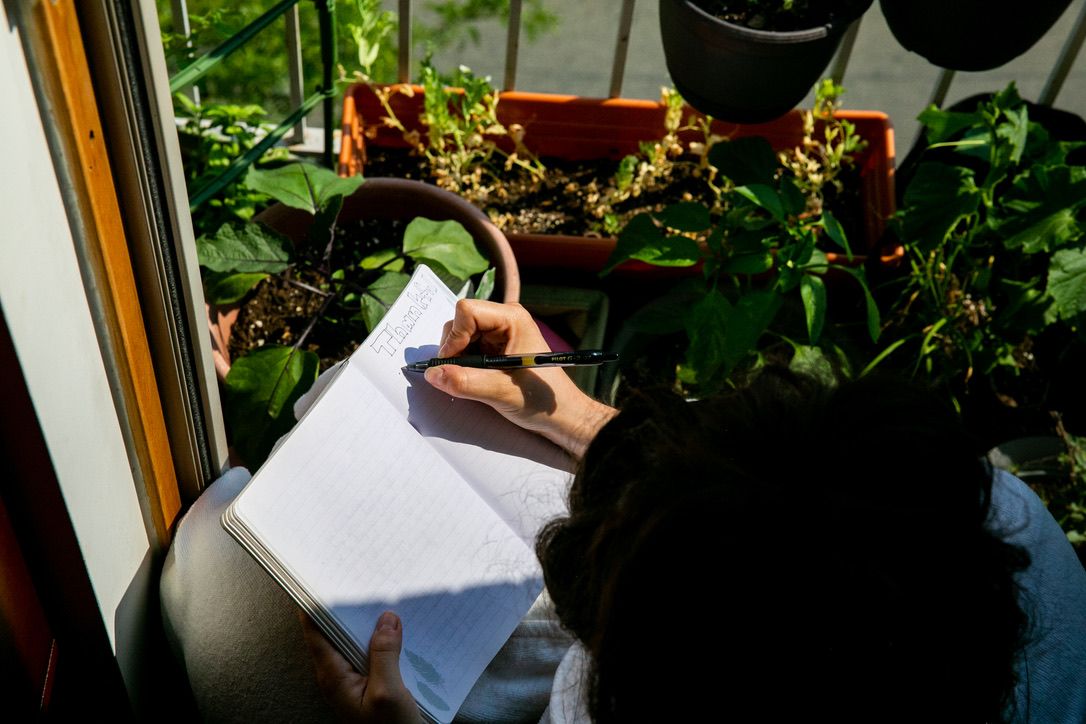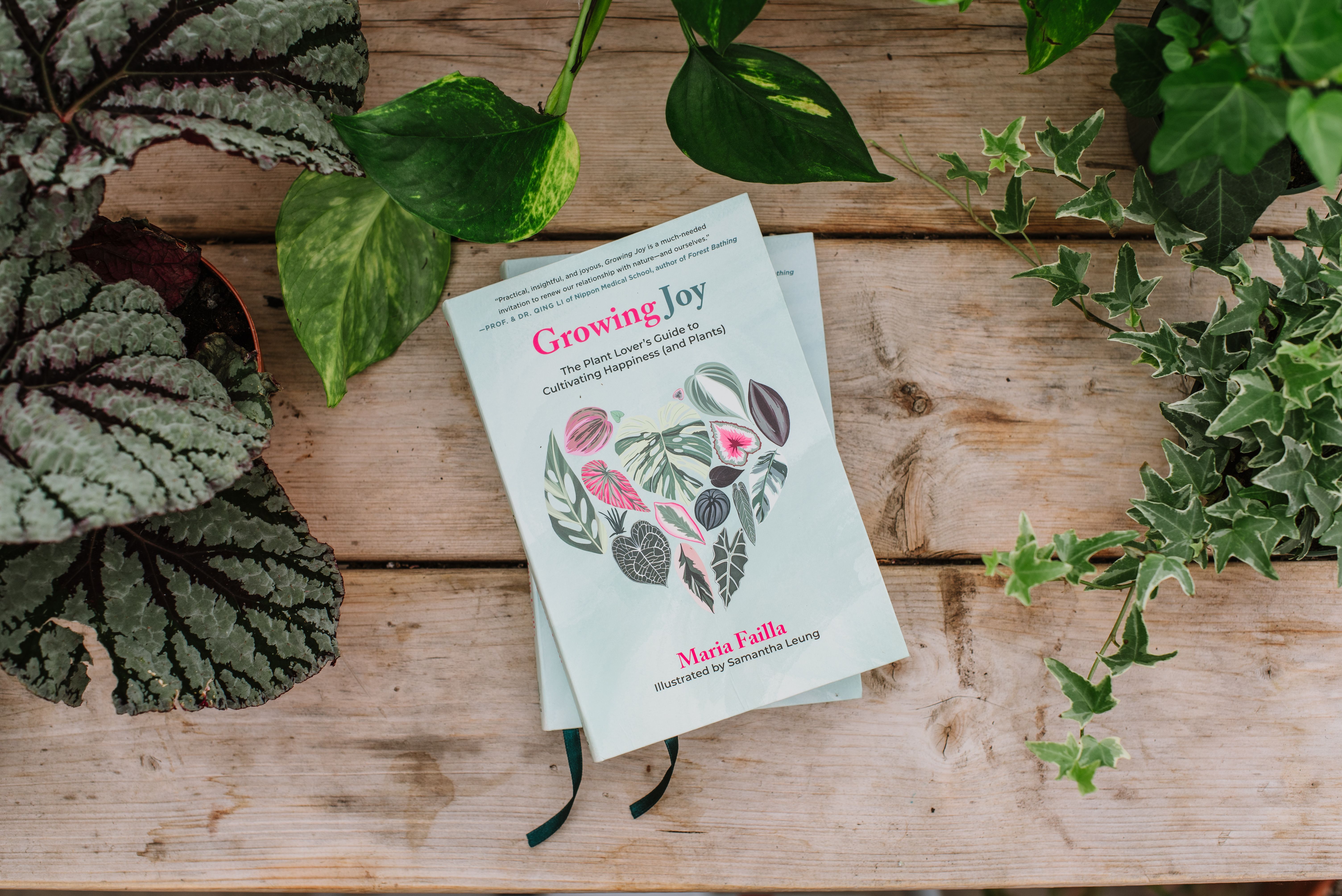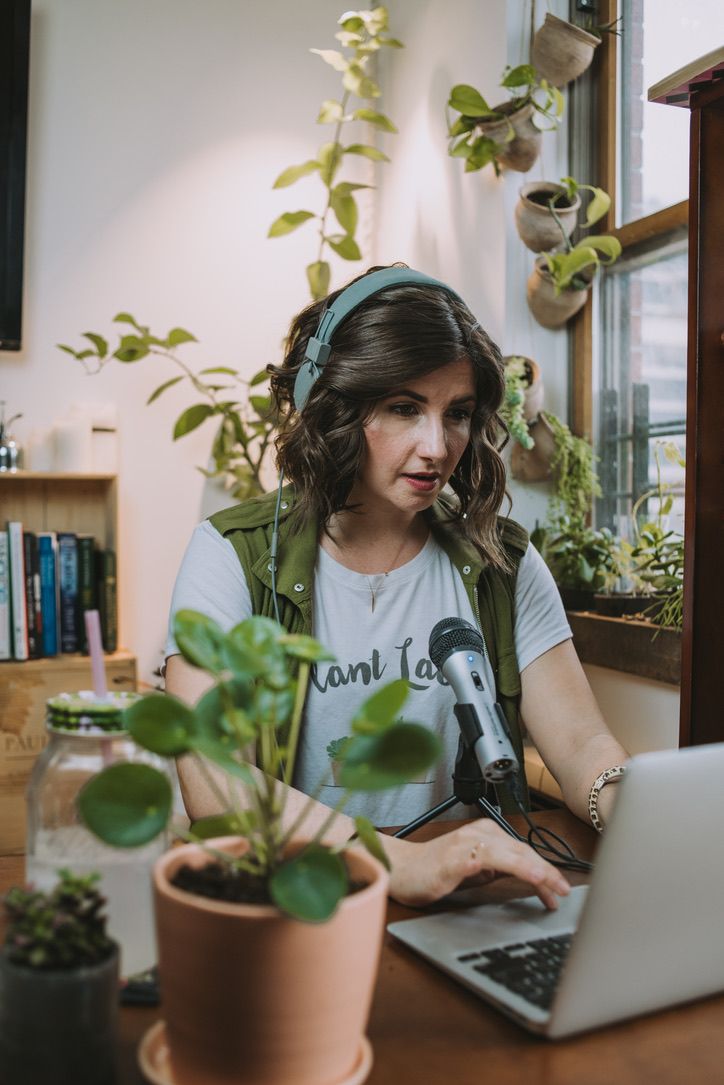
Interviews
Growing Joy Through Houseplants
Maria Failla is on a mission to help you live a happier life through houseplants. To celebrate her new book, Growing Joy: The Plant Lover’s Guide to Cultivating Happiness (and Plants), we sat down with Maria to talk self-care and plant care.

Meet Maria—a self-proclaimed “plant killer turned happy plant lady” who is on a mission to make the world a kinder, and greener, place through houseplants. She is also one of our oldest friends in the plant community. With a new book on the way, Growing Joy: The Plant Lover’s Guide to Cultivating Happiness (and Plants), we sat down with Maria to get the dirt on her journey from plant killer to plant queen.
Hi, Maria! Where are you now?
I’m currently in the Catskills with my husband, 80+ houseplants, and my first stab at an outdoor garden. I lived in NYC in 500 square feet for the last decade, which is where I got into plants, but was part of the “mass exodus” of millennials who left NYC during the pandemic. I was previously a musical theater performer and needed to live in the city for my job, but once the pandemic shut theater down, I decided to evaluate what life could look like outside of the 5 boroughs—something I never thought I’d do.
Yes! When we first met, you were on Broadway. Take us back to the beginning. What were you doing during that time, and how did you get interested in plants?
You were one of the first people I reached out to when I got the idea to start the Bloom & Grow Radio podcast! In 2017 I had two exciting things happen to me: I booked my first Broadway Show (Cats) and moved in with my then-boyfriend, now-husband, Billy.

When we moved in together, I had this strong desire to nest, and a little extra expendable income thanks to Broadway. I decided to try caring for plants, even though I had a notorious record of killing everything I had touched previously. The difference this time was that I actually applied myself—I think I visited The Sill’s blog like every day during this period. I started with a few plants on my windowsills and a small herb garden on my balcony.

Then something unexpected happened: In addition to changing how my home looked, the plants changed the way I approached my day-to-day life. I used to be addicted to my phone—I would wake up, drink my coffee with my phone in hand, and scroll through all of its deliciously addictive apps. When I started caring for plants, I suddenly found myself leaving my phone in its charger and having coffee with my plants in the morning…
I realized by creating that space for plants in the morning, I actually was creating space for myself. In that screen-free quiet time, I not only reconnected with nature through caring for these potted plants but also with myself on a much deeper level. Meditation was always hard for me, but sitting in stillness with my plants wasn’t. Sticking to a gratitude journal was difficult, but being filled with thanks as I watered my plants felt like second nature.

I was so lit up by my personal transformation that I knew I wanted to share this experience with others. I decided to create a podcast about houseplant care—from the perspective of a plant killer—where no question was “too dumb” or simple. My goal was to help the least informed listener successfully care for plants… and cultivate more joy in their life by doing so. Over the years, the podcast has transitioned from a fun passion project to a side-hustle to my full-time job.
For those who aren’t listeners, yet, tell us about the Bloom & Grow Radio Podcast...
Bloom & Grow Radio Podcast is my love letter to plants and the plant community. It’s meant to help everyone care for plants successfully and cultivate more joy in their lives by doing so. That’s the heart and soul of all things Bloom & Grow. I interview experts on a wide variety of topics relating to plant care, but also the plant/person connection. My “Plant Side Chat” series of mini-episodes, where I talk about life lessons learned from my plants, was the inspiration for my book.
What’s your favorite thing about hosting the podcast?
This is a VERY hard question to answer. I think the biggest thing for me is the community of listeners. It still boggles my mind to hear from members of our community, from all over the world, who the show has helped. It feels amazing to be able to contribute in that way. The fact that this little podcast that I started on my couch, with a borrowed microphone and YouTube tutorials, has helped strangers lead happier lives is probably the proudest accomplishment of my life, far beyond what Broadway ever meant to me.

How has your plant parenthood journey changed from early 2020 to now?
I have so many fewer plants! It’s so interesting because I think sharing the number of plants you have has become very “in fashion” over the last few years. Especially in the pandemic, I felt like I saw so many people sharing their collections of hundreds of plants. At the height of my collection, I counted 160 plants in my small 500-square-foot apartment. And that number really was part of my identity as a plant parent. But in the pandemic, we ended up moving 3 times: all different types of homes, with different lighting environments, and one move in the middle of an epic snowstorm…
When we left our apartment, I went from 160 plants to about 80. Then as we kept moving, several plants just couldn’t handle the transition. Now I’m at maybe 60. That experience of whittling down my collection definitely brought up a lot of stress for me. I felt like a bad plant parent, like a failure. But I realized that we, like our plants, go through seasons.
What have you learned in those past two years?
I think my biggest lesson relates to a major plant/life parallel: pruning. When we prune plants, effectively making them smaller, it triggers a growth hormone in the plant to grow more full and lush. So you prune back to inspire growth. In 2020 I lost my job as a performer, left my home in New York City, and rescheduled my wedding THREE times. It felt like everything that made me “me” was taken away. But it was a beautiful lesson. I just kept saying to myself: “After pruning comes new growth. After pruning comes new growth.” It took two years of pain and transition, but I’m finally starting to see the growth that unexpected “life pruning” instigated: this book launch, life in the country with my husband, speaking opportunities, and a business that came from the seed of an idea to start a podcast about houseplants.
”After pruning comes new growth.” is a great mantra. Tell us about your new book, Growing Joy...
Growing Joy is the greatest surprise of my life. It was an opportunity that came out of nowhere and seemed divinely timed. A listener of the podcast happened to be an editor and approached me to see if I’d be interested in writing a book. To share a totally embarrassing story: I actually thought her message was fake and didn’t reply for a while!

Growing Joy is a self-care book about plant care. Every page is dedicated to helping you develop a deeper connection with yourself, through plants. Some pages are practices, some pages are journaling prompts, and some pages are my personal stories. Where I feel like Growing Joy is unique is that it’s not a plant care book per se, but it teaches you how to root your plant care practices in self-care to live a happier life.
I also share a lot of vulnerable stories about my struggles with mental health and how plant care has helped me through it. I ended up having to write the book during one of the most stressful, and arguably least joyful, periods of my life (the IRONY!)

How did you feel at first about sharing your mental health struggles in a public forum?
It’s scary. It’s vulnerable. I’ve had a lot of talks with my husband and family about how transparent I’m being with this book. It’s definitely going to be a side of me that my listeners haven’t seen yet. On the podcast, I try and keep it light and positive, and frankly, more focused on my guests than myself. But when I was writing this book, I realized that the only way I could truly write it was to open up and share my whole self. And my whole self is… flawed…. and struggles with depression and anxiety. I’m just so tired of these curated Instagram pages of perfect-looking plant collections and perfect-looking influencers. I don’t relate to them.
Lately, I’ve been more drawn to the real stuff. I think the pandemic taught us life is just too short. You can be both things: a positive person with a mission to help people, and also struggle with negative thoughts and depression. Just like you can be a great plant parent but still kill plants. So that’s what this book is about: honoring ALL of it. There are plenty of chapters on the sunshiney stuff: the planty affirmations, forest bathing, songs to sing to your plants—but for those who are also struggling, there are stories of how I healed from losing my job as a performer through daily walks in the local woods, how a hand-picked bouquet of wildflowers helped me celebrate my original, canceled, wedding day, and more tough stuff.
Do you have advice for other self-proclaimed plant killers?
Everything in plant parenthood is a teachable moment. Plant fails are crucial to our plant parenthood experience. It’s not about the failure, it’s about how you handle it. So you killed a plant? You can make it mean something about you and label yourself a failure, or you can learn one thing from this plant death that will serve you as a plant parent for the rest of your life. Plant failure is an opportunity to empower yourself with new knowledge.
Also… don’t take it all too seriously! It’s supposed to be fun. Mistakes happen. Plants die. Cats knock over pots of soil. Spider mites invade. It’s all part of the journey.
What's on your nightstand? What are you currently reading?
I host a book club in my Virtual Garden Society and we just read 'Braiding Sweetgrass' by Robin Wall-Kimmerer which changed the way I view nature. It’s hands down my favorite book, and I highly recommend it to anyone with any form of passion for plants. It’s incredible. I also just finished Erin French’s memoir, 'Finding Freedom,' which is an unbelievably inspiring read for any female entrepreneurs out there.
And, of course, we have to ask: What's your favorite plant?
First I have to say, one of my most treasured planters is the blush planter that I got in my first days of plant parenthood from The Sill. This planter is so special to me, it represents all the promise and excitement I was experiencing when I first started Bloom & Grow Radio and purchased it for myself.

In terms of favorite plants, I’m enjoying anything with heart-shaped leaves right now. In my book I talk about a Heart-Shaped Leaf Gratitude Practice: Scatter heart-shaped plants around your home and every time you see one, take a second to send thanks for someone or something in your life. You can try this out with a Philodendron Brasil, Anthurium, and of course, Hoya Heart! I actually gave away Hoya Hearts at my wedding.
Did this interview resonate with you? Then check out Maria’s book, Growing Joy: The Plant Lover’s Guide to Cultivating Happiness (and Plants), and let us know your thoughts!

Words By The Sill
Empowering all people to be plant people—a collection of articles from The Sill's team of plant experts across a variety of plant care topics to inspire confidence in the next generation of plant parents. Welcome to Plant Parenthood™.
Do Some Plant Shopping